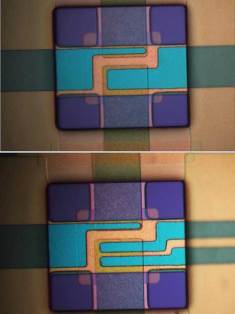Miniature mechanical radiation-resistant logical circuits
 Not a moment too soon after I criticized a statement about lightweight flying robots being used in radiated environments and the fact that electronics in radiation tend to malfunction in a previous article about the AirBurr flying robot, engineers from the University of Utah and the Case Western Reserve University designed microscopic mechanical devices able to operate in conditions with intense radiation and heat.
Not a moment too soon after I criticized a statement about lightweight flying robots being used in radiated environments and the fact that electronics in radiation tend to malfunction in a previous article about the AirBurr flying robot, engineers from the University of Utah and the Case Western Reserve University designed microscopic mechanical devices able to operate in conditions with intense radiation and heat.
Ionizing radiation can quickly fry electronic circuits, so heavy shielding must be used on robots such as those sent to help contain the meltdowns at the Fukushima Daiichi nuclear power plant after Japan’s catastrophic 2011 earthquake and tsunami.
“Robots were sent to control the troubled reactors, and they ceased to operate after a few hours because their electronics failed”, said Massood Tabib-Azar, a professor of electrical and computer engineering at the University of Utah and the Utah Science Technology and Research initiative. “We have developed a unique technology that keeps on working in the presence of ionizing radiation to provide computation power for critical defense infrastructures.”
The new devices are a type of device known as micro-electro-mechanical systems (MEMS) which are capable to perform logical operations such as AND or NOT. For those less familiar with logical operations or Boolean algebra, the combination of negation with an AND or OR logical operation allows the creation of other logical operations (De Morgan’s laws).
Currently used silicon electronics are 1,000 times faster, much smaller, and more reliable because they have no moving parts compared to MEMS. However, silicon electronics rely on semiconducting channels to carry current, and MEMS logic gates are not degraded by ionizing radiation because they lack semiconducting channels. Instead, electrical charges make electrodes move to touch each other, thus acting like a switch.
MEMS logic gate developed by University of Utah engineers measures about 25 x 25 x 0.5 micrometers. The gate has two “bridges” which look somewhat like two tiny microscope slides crossing each other to form a tic-tac-toe pattern, with tungsten electrodes in the center square. Each bridge is made of a glass-like silicon nitride insulator with polysilicon under it to provide rigidity. The insulator is etched and covered by metallic strips of tungsten that serve as electrodes.
The engineers devised a technique to form very narrow gaps between the bridges in the logic gates, thus allowing the devices to operate on voltages as low as 1.5 volts – a figure much lower compared to usual 10 to 20 volts MEMS usually require. Another benefit of using a single MEMS device as a logic gate is the fact it reduces the numbers of separate MEMS switches which were required to form same operations, thus increasing the reliability and speed.
The researchers showed the devices kept working despite intense ionizing radiation and heat by dipping them for two hours into the 90-kilowatt TRIGA research reactor of the University of Utah’s research reactor. The devices also operated while they were placed on a hot plate in a vacuum chamber and heated to 136 °C (277 °F) for an hour. The logic gates were tested outside the reactor and oven, where they have been able to run for more than a billion cycles without failure (around 2 months of operation), but the engineers plan to further improve their reliability.
The engineers hope they’ll be able to obtain the funding which would enable them to build a little computer using these radiation and heat resistant logic gates and circuits. The technology could be used for robots and computers exposed to radiation in space or other scenarios with radiated terrestrial areas.










Leave your response!